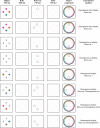Mixing and mingling in visual working memory: Inter-item competition is feature-specific during encoding and feature-general during maintenance
- PMID: 39134920
- PMCID: PMC11410897
- DOI: 10.3758/s13414-024-02933-3
Mixing and mingling in visual working memory: Inter-item competition is feature-specific during encoding and feature-general during maintenance
Abstract
Visual working memory (WM) is a central cognitive ability but is capacity-limited due to competition between remembered items. Understanding whether inter-item competition depends on the similarity of the features being remembered has important implications for determining if competition occurs in sensory or post-sensory stages of processing. Experiment 1 compared the precision of WM across homogeneous displays, where items belonged to the same feature type (e.g., colorful circles), and heterogeneous displays (e.g., colorful circles and oriented bars). Performance was better for heterogeneous displays, suggesting a feature-specific component of interference. However, Experiment 2 used a retro-cueing task to isolate encoding from online maintenance and revealed that inter-item competition during storage was not feature-specific. The data support recent models of WM in which inter-item interference - and hence capacity limits in WM - occurs in higher-order structures that receive convergent input from a diverse array of feature-specific representations.
Keywords: Sensory recruitment hypothesis; Visual working memory; Working memory interference.
© 2024. The Author(s).
Conflict of interest statement
The authors have no conflicts of interest.
Figures









Similar articles
-
Selection within working memory based on a color retro-cue modulates alpha oscillations.Neuropsychologia. 2017 Nov;106:133-137. doi: 10.1016/j.neuropsychologia.2017.09.027. Epub 2017 Sep 27. Neuropsychologia. 2017. PMID: 28958909
-
The transition from feature to object: Storage unit in visual working memory depends on task difficulty.Mem Cognit. 2019 Nov;47(8):1498-1514. doi: 10.3758/s13421-019-00956-y. Mem Cognit. 2019. PMID: 31267436
-
No age deficits in the ability to use attention to improve visual working memory.Psychol Aging. 2016 Aug;31(5):456-70. doi: 10.1037/pag0000107. Epub 2016 Jun 2. Psychol Aging. 2016. PMID: 27253868
-
Refreshing memory traces: thinking of an item improves retrieval from visual working memory.Ann N Y Acad Sci. 2015 Mar;1339:20-31. doi: 10.1111/nyas.12603. Epub 2014 Dec 30. Ann N Y Acad Sci. 2015. PMID: 25557544 Review.
-
Working memory needs pointers.Trends Cogn Sci. 2025 Mar;29(3):230-241. doi: 10.1016/j.tics.2024.12.006. Epub 2025 Jan 7. Trends Cogn Sci. 2025. PMID: 39779443 Review.
Cited by
-
Modality-, feature-, and strategy-dependent organization of low-level working memory.J Vis. 2025 Jan 2;25(1):16. doi: 10.1167/jov.25.1.16. J Vis. 2025. PMID: 39873647 Free PMC article.
References
-
- Adam, K. C. S., Rademaker, R. L., & Serences, J. T. (2022). Evidence for, and challenges to, sensory recruitment models of visual working memory. In Visual Memory (pp. 5–25). Routledge.
-
- Agostinelli, C., & Lund, U. (2023). R package circular: Circular Statistics (version 0.5–0).
-
- Alvarez, G. A., & Cavanagh, P. (2004). The capacity of visual short-term memory is set both by visual information load and by number of objects. Psychological Science,15(2), 106–111. - PubMed
-
- Avital-Cohen, R., & Gronau, N. (2021). The asymmetric mixed-category advantage in visual working memory: An attentional, not perceptual (face-specific) account. Journal of Experimental Psychology. Human Perception and Performance, 47(6), 852–868. - PubMed

